
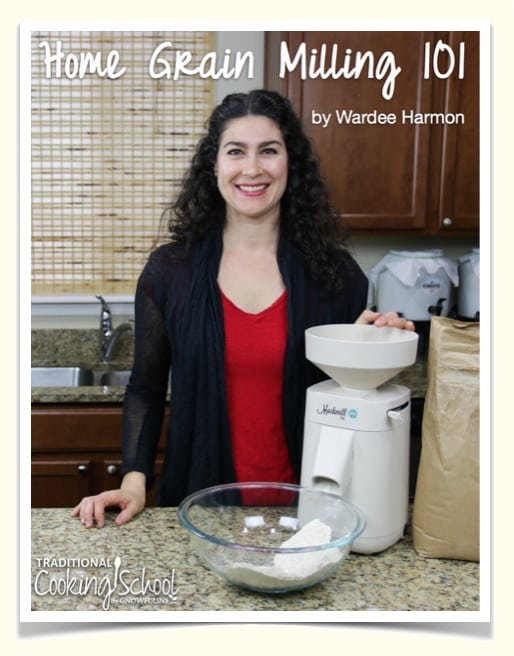 This is part 3 of 4. Want all 4 parts of the “Home Grain Milling 101” series combined into a FREE all-in-one eBook you can refer to offline?
This is part 3 of 4. Want all 4 parts of the “Home Grain Milling 101” series combined into a FREE all-in-one eBook you can refer to offline?
Click here to download the “Home Grain Milling 101” eBook for FREE!
Store-bought vs. fresh-ground flour?
Not. The. Same.
In Part 1 of our Home Grain Milling 101 series and this FREE webclass, I hope I convinced you of the healthfulness, tastiness, and frugality of home-milled flours (among other things)…
…so now let’s talk about how differently that fresh-milled flour performs in baking.
Namely, what you have to do so that things turn out right! Because it’s all about the end results, isn’t it?
Here’s the deal: store-bought flours sit on the shelf awhile. During which time, they get compacted and more dense.
On the other hand, freshly milled flour is light and fluffy — almost as if it was just sifted.
For instance, a cup of store-bought flour contains much more flour by weight than a cup of fresh-milled flour does. (Just another reason to go by weights for accuracy, but I’ll talk about that later.)
So, what do you do? How do you account for this in recipes where the flour is not necessarily fresh-ground?
That’s what we’re talking in today’s Part 3 of our Home Grain Milling 101 series!
By the way, in Part 1 we covered the basics (why do it, mill types, how to use a mill, etc.) and in Part 2 we talked about milling gluten-free grains. The final (next week), we’ll cover other fun things to do with your grain mill. 🙂
Check out the particulars of today’s discussion on baking with fresh-milled flours — including a milling demonstration — in today’s #AskWardee in print, podcast, or video below! And be sure to come back every Wednesday throughout this month of November for the rest of the series!
Subscribe to #AskWardee on iTunes, Stitcher, YouTube, or the Podcasts app.
Q: What Adjustments Do You Make When Baking With Fresh-Ground Flour Instead Of Store-Bought?
Laurie Neverman from Common Sense Homesteading asks:
How about adjusting recipes that typically use pre-milled flour?
Pound for pound, freshly ground flour fills up more space than flour which is not freshly ground. You see, flour settles over time.
If a recipe is written with volumes (cups, for example) and calls for unsifted flour which is not fresh-ground, expect to add more of your fresh-ground flour to get the right consistency. Usually, 2 tablespoons more per cup is the right amount, but it could be more or less.
If a recipe is written with weights (grams) and calls for unsifted white flour and you are using fresh-ground whole grain flour, you will use a little less than the recipe calls for.
If the recipe is written with weights and calls for unsifted whole grain flour and you are using fresh-ground whole grain flour, usually no adjustments are needed.
We use weights in our Einkorn Baking eCourse and Einkorn Baking eBook & Video Package. It helps a lot to ensure great results! This is the scale we use and recommend.
You should also keep in mind what you are baking. It’s not always a matter of just subbing the flour. Because a fine pastry still wants a finer flour. A heartier bread loves a heartier flour. And so on.
If you live in a dry climate, you might need to use less flour overall, or more liquid to account for the drier flour. And, high altitude can effect baked goods. In general, use any techniques you have found to be helpful in the past when adjusting recipes for high altitude.
Hotter temperatures (in addition to longer souring times) make for runnier batters, so often more flour is needed when making a recipe in the summer than in the winter. In dry climates, flour is more dry and sucks up more moisture, which means you should start out with less flour.
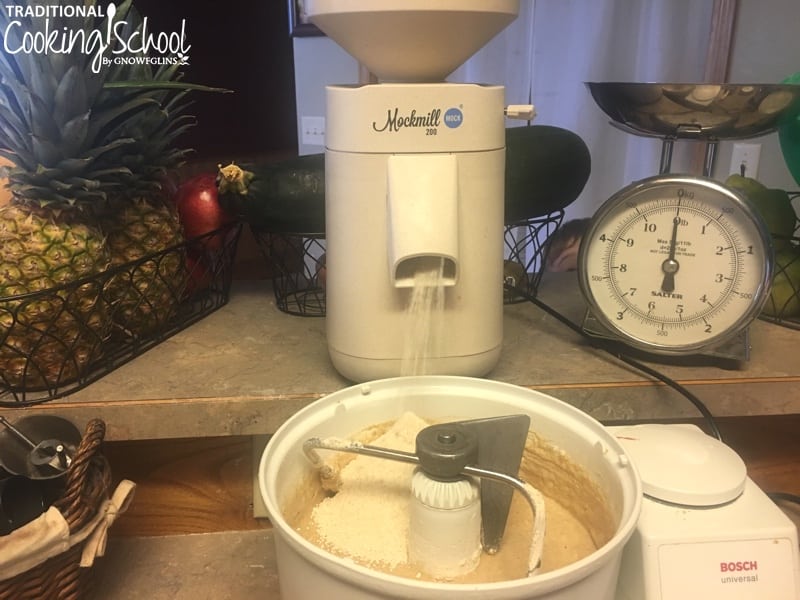
Q: How Do I Know How Much Flour I Need To Grind?
Helen T. pointed out:
It’s sometimes hard to grind exactly how much flour you need!
Yes, it is — and I’d love to help with some simple tips!
Professional bakers go by weights, so they know if they need 100 grams of flour, they grind 100 grams of whole wheat berries. You see, the weights don’t change when going from grain to flour. So if you’re using a recipe that’s in grams, you simply grind that amount of grain. (Provided it’s an equivalent type of grain.)
Volume does change, though! Although it’s going to be different from grain to grain, a pretty good formula you can follow is you’ll get 1 cup of flour from every 1/2 cup of grain.
If you need help converting ingredients from cup to metric, here’s a converter that I think is pretty good.
In addition to mastering the metrics, I want to encourage you to change your thinking (as I have done recently!) to embracing this concept of milling on demand. Not only will you not have to store and account for extra flour, your baked goods will turn out better than ever because the flour that’s in them is as fresh-as-fresh-can-be!
And with mills like the Mockmill, it’s even easier to mill on demand! The low profile and the design make it really, really simple to put just the amount of grain you need through the stones and the flour will come out the spout.
Above is a photo from Jade and Julie Koyle, our friends at Ancient Grains, LLC. She puts her mill on that level above the mixer and mills a bit at a time as she’s creating her bread dough. It falls right into the mixing bowl. I love it! She saves on dishes, too!
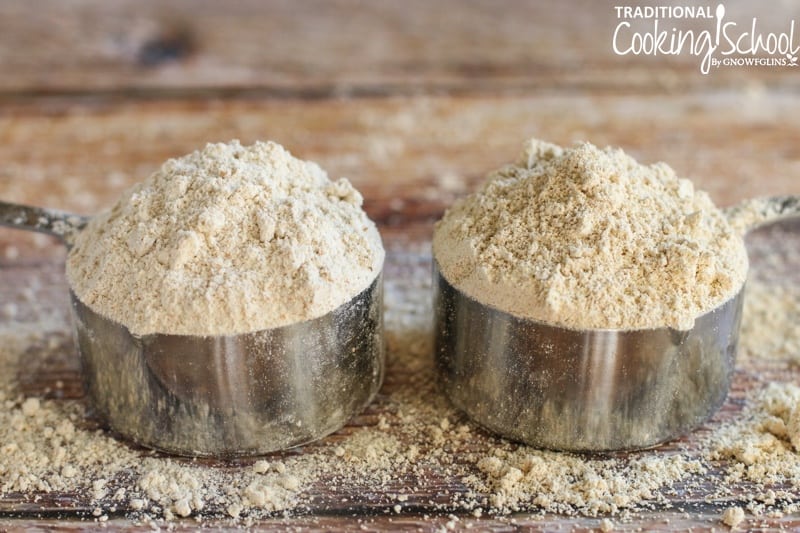
Q: Should We Still Use Traditional Food Preparation Methods?
Rebecca S. is full of questions:
Soaking grains for flour… After grinding? Let the batter sit? Leave out leavening?
You should absolutely use traditional food prep methods such as soaking when milling your own flour. The anti-nutrients present in grains are still a concern with fresh-ground flour. So we still advocate for soaked, sprouted, or sourdough recipes.
Here’s how it works for each method:
- Soaking — mill flour, use in soaked recipe (flour + liquid + acid combined and left to soak; leavenings and add-ins worked in at the end before baking)
- Sprouting — sprout whole grains, dehydrate until dry, mill into flour, use in recipes (no need to soak or sour, though you can)
- Sourdough — mill flour, use in true sourdough recipes (flour + liquid + sourdough starter combined and left to soak; leavenings and add-ins worked in at the end before baking)
What do I mean by true sourdough? I mean that there is enough time and enough warmth involved in the process that all the flour in the recipe benefits from this nutritious method — not just some of the flour for some of the time.
You can learn more about this in #AskWardee: Is Store-Bought Sourdough Bread True Sourdough? And rest assured, all the recipes you find here, in our eCourses, or in our publications are truly nourishing! No shortcuts! (But still simple and delicious!)
In a nutshell: All TCS recipes allow for all of the flour to be soured. In general, the longer the souring time, the better for nutrition. Those yeasts and bacteria are great at their jobs — breaking down anti-utrients for better digestion. However, in the case of rolled doughs, such as tortillas and pizza crusts, souring too long results in a dough with no elasticity left. In other words, the dough breaks and cannot be rolled out very well. We suggest no more than 8 or 12 hours of souring at warm temperatures for these recipes. If your temperature is cooler, you will be able to lengthen the souring time without negative results.
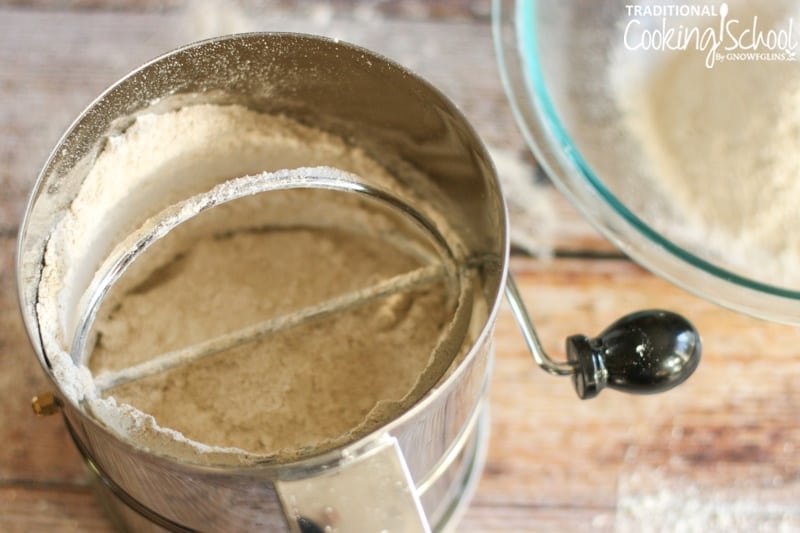
Q: Should I Sift My Fresh-Ground Flour?
Marilee S. asked:
How do you make “all purpose” flour at home, including sifting some of the bran out?
Jenika J. added:
What would be the easiest way or even the benefits (if any) of sifting the ground flour for recipes the require “softer” flour?
Rene G. wants to know:
To sift or not to sift… or when to sift?
Although fresh-milled flour is pretty fluffy, it still contains the heavier parts of the grain (like bran). If you are making a pastry or prefer a lighter end results than whole grain flour provides, by all means, sift! I use this 8-cup hand-crank sifter.
Q: My Bread Is Too Heavy! What Can I Do?
Aubree K. shared:
We have been baking sourdough with white flour (organic, unbleached), but I’d really really love to own a mill and grind at home. We just aren’t crazy about “whole wheat” taste and texture. But if the nutrition is truly higher, then we’d be willing to experiment and adjust our tastes. There are so many milling options as well, it is confusing to know which one would be right for us, baking a loaf maybe once per week… more during the holidays as gifts, etc.
Yes, the whole grain taste takes some adjustment. You do have options, though.
First, fresh-ground tastes way better than store-bought flour. If your whole wheat taste came from older flour, it likely was rancid.
Second, you need a mill that can make fine flour, such as the Mockmill.
Third, you could switch to using lighter-flavored and lighter-textured grain. For instance, switch to white whole wheat (a lighter and sweeter variety of wheat). You could also switch to an older variety of wheat, like spelt or einkorn, which yield lighter results in my opinion.
Finally, if your family still wants lighter bread and flavor, then consider sifting part or all of your flour to lighten up the taste/texture.
Other things to look at include:
- Leavening — Is there enough? Is the sourdough starter strong enough?
- Temperature — Is the dough warm enough when rising?
- Amount of flour — Too much flour can lead to a dense, heavy result.
Q: How Long Does Fresh-Ground Flour Last?
Copying this from Part 1 here.
Helen T. asked:
Just how quickly do grains “degrade” once milled? Is it that bad to grind some ahead and store in the freezer? If I’m making something in the morning and then in the evening, can I leave that flour out all day? I wonder just how quickly homemade flour goes “bad”. I keep leftovers (since it’s sometimes hard to grind exactly how much you need!) in the freezer for things like roux.
You should use your fresh-ground flour within three days of grinding (room temperature), or refrigerate for up to seven days, or freeze up to six months. Milled grains should not be stored at room temperature for more than three days because of the danger of rancidity. Here are more details on how to store flour and grains.
Sprouted flour should be used/stored similarly. Although it does last longer than unsprouted, I follow these guidelines to be on the safe side of rancidity. 🙂
Q: Do You Treat Sprouted Flours Differently When Baking?
Janet C. asked:
Do you treat sprouted flours differently when baking (i.e. knead less, more hydration, longer rising times)?
Great question! Sprouting is one of the traditional grain prep methods that prepares grains for best digestion and nutrition. Because it’s a method on its own, you don’t need to combine it with soaking or sourdough in a recipe — though you can.
In general, sprouted flours produce baked goods that are a little more crumbly and fragile. Therefore, eggs or other binders really help in sprouted recipes. Other than that, you can simply follow the subbing guidelines I shared above to get the right amount for the recipe.
In Part 4 of this series, I’ll show you how to grind your own sprouted flour at home. The picture above shows sprouted einkorn chocolate chip cookies, a recipe that’s in our Einkorn Baking eCourse and Einkorn Baking eBook & Video Package.
Q: Is Fresh-Ground Flour As Fine As Store-Bought?
Michelle D. asks:
It hadn’t crossed my mind that you could mill your own flour. So I guess my questions would be: What equipment do you need? Can use what I have already at home or do I need special equipment? How long does it take to do? Are the results the same as what you would normally buy or is there a difference in the texture, quality or “fineness”? Is it complicated or time-consuming?
The fineness and results largely depend on the mill you’re using. I get extremely fine results from our home stone grain mill, the Mockmill. And I used to with our impact mill, the Nutrimill, as well. (I prefer the Mockmill because it’s more versatile and can do a coarser grind and crack grains as well.)
I started home milling with a Vitamix, and while it was ok, I never got what I would consider “fine” flour.
There’s more on the different mill types here.
My Favorite Grain Mill: The Mockmill
As you can tell from this series, the Mockmill is my favorite grain mill and the one I recommend!
The Mockmill is a home stone grain mill, and it’s engineered and manufactured in Germany by Wolfgang Mock. He started making home grain mills back in the 1970s, so he’s been doing it for over 40 years. It’s estimated that nearly 70% of the stone mills out there are made by him.
This mill is super exciting because it contains the best features of Wolfgang Mock’s milling career, yet it’s much more affordable. The reason it’s more affordable is because this mill comes in a durable recycled material housing (instead of expensive wood).
I love the flour it produces because it’s super healthy and nutritious (being fresh ground), and it has a really fine texture. So, it makes wonderful, light bread, and it’s cool to the touch instead of being warmed up as some mills will do.
Furthermore, this mill will grind all grains, even gluten-free. It can even crack grains for porridge, and it has many other uses (like spices, nuts, and seeds).
All the details — including the very affordable price and FREE SHIPPING — are on this page. By the way, it also comes as a KitchenAid attachment — very exciting for those who don’t want another appliance to take up any more room!
And, for a limited time… if you decide to purchase the Mockmill, I’m throwing in complimentary copies of both my Sourdough A to Z and Einkorn Baking eBook and Video Packages. They’re each worth $64 for a total of $128 in additional bonuses from me.
To claim your extra free bonuses from me after purchasing the Mockmill, just go to tradcookschool.com/millbonus. Have your order # handy, because you’ll need it to claim the two free eBook packages!
 This part 3 of 4. Want all 4 parts of the “Home Grain Milling 101” series combined into a FREE all-in-one eBook you can refer to offline?
This part 3 of 4. Want all 4 parts of the “Home Grain Milling 101” series combined into a FREE all-in-one eBook you can refer to offline?
Click here to download the “Home Grain Milling 101” eBook for FREE!
Helpful Links
- The Mockmill — my favorite and recommended (affordable) home stone grain mill — Hurry! The limited time offer to get my eBook packages valued at $128 won’t last long!
- Claim your FREE ($128 value) bonuses with your purchase of the Mockmill here!
- Nutrimill
- Vitamix
- Free “Home Grain Milling 101” eBook — it’s all 4 parts of this series combined into a single, FREE download from me!
- Home Grain Milling 101, Part 1: The Basics
- Home Grain Milling 101, Part 2: Milling Gluten-Free Grains Into Flour
- Home Grain Milling 101, Part 4: More Fun Things Your Grain Mill Can Do!
- Ancient Grains 101
- FREE Webclass: Baking With Fresh-Ground Flour
- FREE No-knead Sourdough Einkorn Bread Recipe
- Why I <3 Einkorn — in case you want to know why we bake with the healthier 5,000 year-old wheat called einkorn!
- Where To Buy Einkorn
- The scale we use and recommend
- Cup to gram converter
By the way, I want to give credit to Vickilynn Haycraft, my dear friend and “milling mentor”, who introduced me to grain milling years ago and who contributed to some of these answers. I also want to thank Wolfgang Mock, whose stone grain mill — the Mockmill — I am using for demonstrating various milling tasks in this series. And finally, I want to thank Jade Koyle from Einkorn.com for his wonderful einkorn grain and help with using the Mockmill!
More Mockmill Related Articles from the #AskWardee Show:
- Unboxing The Mockmill (Affordable Home Stone Grain Mill)
- Differences Between Nutrimill And Mockmill #AskWardee 120
- How To Simply & Easily Clean Your Mockmill Grain Mill #AskWardee 119
- Where To Buy Whole Wheat Berries, Grains, and Flour #AskWardee 148
- How to Store Flour and Grains#AskWardee 149
- Buckwheat Flour 101: Choosing, Milling Flour, Sprouting, Recipes & More! #AskWardee 141
- Milling Soft Wheat In A Grain Mill {Homemade Pastry Flour} #AskWardee 131
- How To Sift Flour… aka Homemade “All-Purpose” Flour #AskWardee 117
- Is The New Ultragrain White Whole Wheat Healthy? #AskWardee 112
Do you bake with fresh-ground flour? What tips or advice would you add?
...without giving up the foods you love or spending all day in the kitchen!

2 free books:
Eat God's Way
Ditch the Standard American Diet, get healthier & happier, and save money on groceries...
We only recommend products and services we wholeheartedly endorse. This post may contain special links through which we earn a small commission if you make a purchase (though your price is the same).


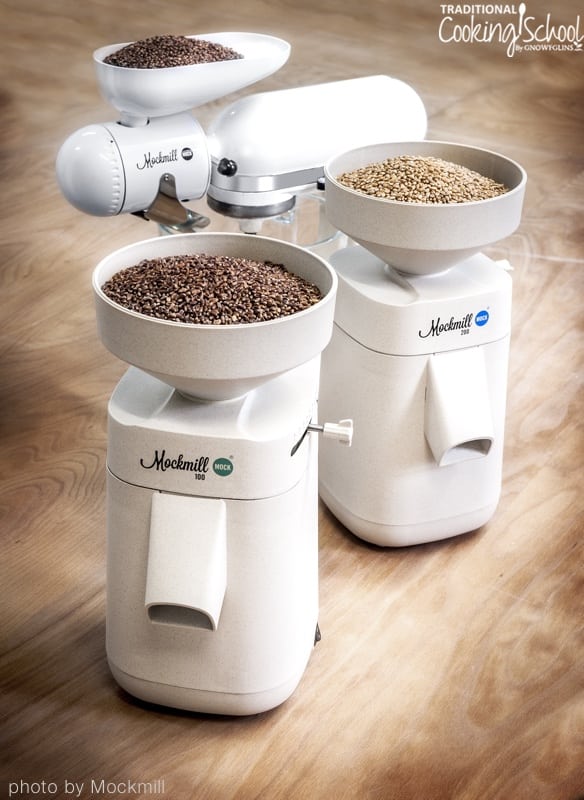



Thanks Wardee for such a great information. I would like to try this at home. Keep up the great work.
Wardee,
I have previously heard that the germ causes whole wheat flour to quickly go rancid as you mentioned. I have a question regarding flours that are labeled whole wheat flour in stores, such as Bob’s Red Mill Whole Wheat flour. What allows them to have a longer shelf life? Added ingredients or are they not truly whole wheat?
Thank you!
Hi Kathy,
According to Bob’s Red Mill’s website the only ingredient in their whole wheat flour is whole grain hard red wheat. So the flour does contain the bran and germ and no preservatives or additives.
You can extend the shelf life of whole grain flours by properly storing them in the freezer or refrigerator. If in doubt of whether or not your whole grain flour has gone rancid, give it a smell. If it smells fresh, the flour is still good.
~ Vicki, TCS Customer Success Team
I’m wanting to start a sourdough starter with freshly ground flour. I’ve had someone tell me to grind 1 gallon of flour and keep it at room temp for feedings….this doesn’t make sense to me as the flour goes rancid. I’ve been told also that starter doesn’t like cold flour. What do you recommend as I don’t want to mill my flour that often for time purposes. Thank you
Hi, Lisa,
You may find Wardee’s posts helpful, she answers your questions here:
https://traditionalcookingschool.com/food-preparation/is-aged-flour-better-for-sourdough-askwardee-122/?swcfpc=1
https://traditionalcookingschool.com/q-a/askwardee-020-can-i-use-cold-flour-or-water-in-my-sourdough-starter-or-recipes/?swcfpc=1
I use store bought organic flour to feed my starter and freshly milled flour (because spelt and einkorn are expensive where I live) when I go to use it in a recipe.
~Peggy, TCS Customer Success Team
I had a bread recipe that worked great for whole wheat flour. Since I started grinding my own wheat it is much heavier. I weighed the flour so the volume isn’t the issue. I add a little more water but that still doesn’t do the trick. Any advice?
Hi Carol, we do have another post of less dense sourdough bread. I’m not sure if you’re using sourdough or not but perhaps some of the suggestions could help you. https://traditionalcookingschool.com/food-preparation/weekly-kitchen-tips/less-dense-sourdough-bread-aw053/
~ Vicki, TCS Customer Success Team
I am interested in getting the recipe in the picture that was in the pin! The chocolate chip cookies with freshly milled flour! Would you mind sharing that, since you have a photo in this post? Thanks so much.
Hi Spring, the sprouted Einkorn chocolate chip cookie recipe is only available in our Einkorn Baking eCourse or eBook. You can check these out here: https://lp.traditionalcookingschool.com/lp/ebook-einkorn-baking/?swcfpc=1
~ Vicki, TCS Customer Success Team